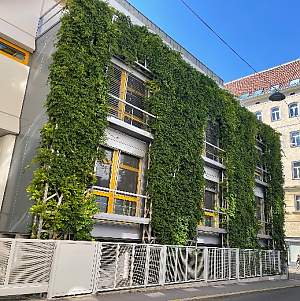HEDWIG - Collection of measurement data to assess the impact of green buildings
Short Description
Status
ongoing
Starting point / motivation
The effects and benefits of Green Infrastructure have become a global research interest. However, reliable data on the effects, especially of building greening, are still not available.
The study "Effects of the Green City" (Stangl et al. 2019) provided an overview of the international state of knowledge on measurable effects and parameters of greening measures. Cooling effects and the associated energy savings often are the focus of scientific work, and the spectrum of parameters collected, is wide. Still, inaccurate representations and information on the underlying data or measurement setups, the non-comparability of the published parameters and the lack of causal relationships are problematic.
Overall, the state of knowledge is still fragmented and contradictory, reducing the information value of even up-to-date studies and results. For example, there are not yet characteristic values available for the integration in the energy certificate for greening buildings. Investments in GI are often controversial, as evidence of the benefits versus the costs is lacking.
Contents and goals
The HEDWIG project aims to determine the effects of standard-compliant building greening (green roofs and facades) in the course of permanent monitoring. Sound and resilient vegetation and performance parameters will be obtained and related to the effects of building greening on the indoor climate and the exterior microclimate.

Methods
HEDWIG develops and verifies a measurement setup suitable for the collection of valid data, their comparability and the evaluation of Green Infrastructure demonstration projects. HEDWIG collects microclimatic and building physical data from 15 representative green buildings with heterogeneous age structures and different types of use. Measurement campaigns and continuous measurements will be applied over two years. Parameters such as transmissivity of climbing plants, heat flux through green roof structures or indoor thermal comfort are recorded in a structured and standardized way.
This allows for developing standard parameters for green infrastructure typologies and transfer them to planning and implementation processes. The measurements are supplemented and supported by thermal building simulations. A data evaluation procedure will be developed and standardized to enable cross-site comparisons. Periodically occurring effects as well as favorable and disruptive influencing factors will be identified and made calculable.
New findings are in particular expected on the microclimatic influence of green bodies on the building envelope and the interior. An optional objective is assessment of microclimatic effects for the adjacent street space and urban area.
Expected results
The HEDWIG measurement and analysis methodology will be documented in a comprehensible way and made available as open content for future research and demonstration projects. The findings from the key values and effects should enable the further development of calculation models, promote the further mainstreaming of green buildings and form the basis for argumentation and approval processes.
Project Partners
Project management
Univ.Prof. DIDr. Rosemarie Stangl - University of Natural Resources and Life Sciences (BOKU), Institute of Soil-Bioengineering and Landscape Construction (IBLB)
Project or cooperation partners
- RED Bernard GmbH
- IBO Verein und GmbH
- GRÜNSTATTGRAU
Contact Address
University of Natural Resources and Life Sciences (BOKU)
Institute of Soil-Bioengineering and Landscape Construction (IBLB)
Univ.-Prof. DI Dr. Rosemarie Stangl
Peter Jordan-Straße 82
A-1190 Vienna
Tel. +43 (1) 47654 87400
E-mail: rosemarie.stangl@boku.ac.at
Web: https://boku.ac.at/baunat/iblb
